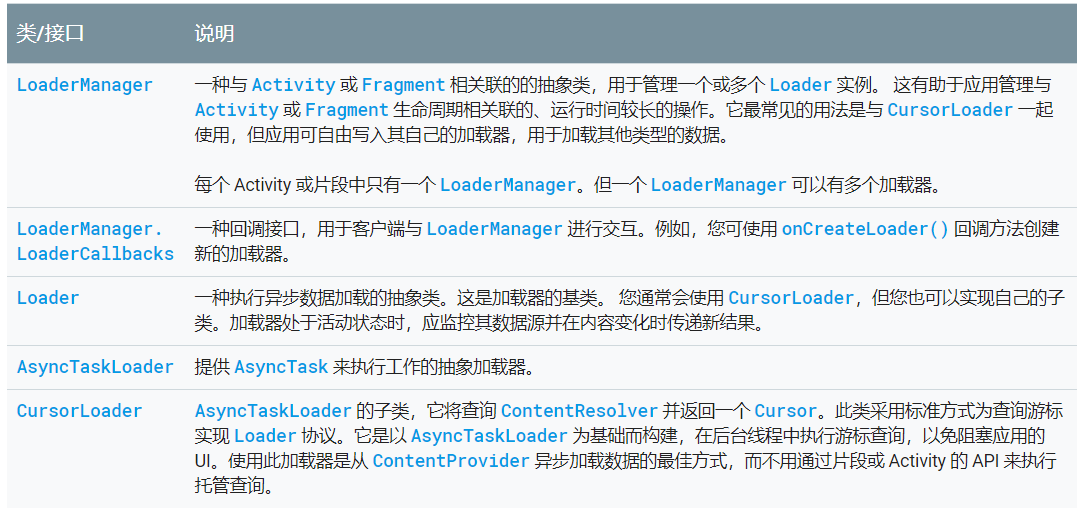[TOC] 1.載入器特征 用於每個 和 支持非同步載入數據。 監控其數據源併在內容變化時傳遞新結果。 2. Loader API 3. 在應用中使用Loader 主要步驟 1. 或 2. 的實例 3. 一個 ,用於載入由 支持的數據。您也可以實現自己的 或 子類,從其他源中載入數據。 4. 一個 實 ...
目錄
1.載入器特征
- 用於每個
Activity和Fragment
- 支持非同步載入數據。
- 監控其數據源併在內容變化時傳遞新結果。
2. Loader API

3. 在應用中使用Loader
主要步驟
Activity或FragmentLoaderManager的實例- 一個
CursorLoader,用於載入由ContentProvider支持的數據。您也可以實現自己的Loader或AsyncTaskLoader子類,從其他源中載入數據。 - 一個
LoaderManager.LoaderCallbacks實現。您可以使用它來創建新載入器,並管理對現有載入器的引用。 - 一種顯示載入器數據的方法,如
SimpleCursorAdapter。 - 使用
CursorLoader時的數據源,如ContentProvider。
3.1. 啟動載入器
在 Activity 的 onCreate() 方法或片段的onActivityCreated() 方法內初始化 Loader
// Prepare the loader. Either re-connect with an existing one,
// or start a new one.
// 標識ID + 構建時給載入器的可選參數 + LoaderManager.LoaderCallbacks 實現
getLoaderManager().initLoader(0, null, this);
// 如果 ID 指定的載入器已存在,則將重覆使用上次創建的載入器。
// 如果 ID 指定的載入器不存在,則 initLoader() 將觸發 LoaderManager.LoaderCallbacks 方法 onCreateLoader()3.2. 重啟載入器
public boolean onQueryTextChanged(String newText) {
// Called when the action bar search text has changed. Update
// the search filter, and restart the loader to do a new query
// with this filter.
mCurFilter = !TextUtils.isEmpty(newText) ? newText : null;
getLoaderManager().restartLoader(0, null, this);
return true;
}3.3. 使用LoaderManager回調
LoaderManager.LoaderCallbacks 是一個支持客戶端與LoaderManager 交互的回調介面。
- 載入器(特別是
CursorLoader)在停止運行後,仍需保留其數據。這樣,應用即可保留Activity或片段的onStop()和onStart()方法中的數據。當用戶返回應用時,無需等待它重新載入這些數據。您可使用LoaderManager.LoaderCallbacks方法瞭解何時創建新載入器,並告知應用何時停止使用載入器的數據。
LoaderManager.LoaderCallbacks包括以下方法:onCreateLoader():針對指定的 ID 進行實例化並返回新的 LoaderonLoadFinished():將在先前創建的載入器完成載入時調用onLoaderReset():將在先前創建的載入器重置且其數據因此不可用時調用
4. 實例: 訪問用戶聯繫人
public static class CursorLoaderListFragment extends ListFragment
implements OnQueryTextListener, LoaderManager.LoaderCallbacks<Cursor> {
// This is the Adapter being used to display the list's data.
SimpleCursorAdapter mAdapter;
// If non-null, this is the current filter the user has provided.
String mCurFilter;
@Override public void onActivityCreated(Bundle savedInstanceState) {
super.onActivityCreated(savedInstanceState);
// Give some text to display if there is no data. In a real
// application this would come from a resource.
setEmptyText("No phone numbers");
// We have a menu item to show in action bar.
setHasOptionsMenu(true);
// Create an empty adapter we will use to display the loaded data.
mAdapter = new SimpleCursorAdapter(getActivity(),
android.R.layout.simple_list_item_2, null,
new String[] { Contacts.DISPLAY_NAME, Contacts.CONTACT_STATUS },
new int[] { android.R.id.text1, android.R.id.text2 }, 0);
setListAdapter(mAdapter);
// Prepare the loader. Either re-connect with an existing one,
// or start a new one.
getLoaderManager().initLoader(0, null, this);
}
@Override public void onCreateOptionsMenu(Menu menu, MenuInflater inflater) {
// Place an action bar item for searching.
MenuItem item = menu.add("Search");
item.setIcon(android.R.drawable.ic_menu_search);
item.setShowAsAction(MenuItem.SHOW_AS_ACTION_IF_ROOM);
SearchView sv = new SearchView(getActivity());
sv.setOnQueryTextListener(this);
item.setActionView(sv);
}
public boolean onQueryTextChange(String newText) {
// Called when the action bar search text has changed. Update
// the search filter, and restart the loader to do a new query
// with this filter.
mCurFilter = !TextUtils.isEmpty(newText) ? newText : null;
getLoaderManager().restartLoader(0, null, this);
return true;
}
@Override public boolean onQueryTextSubmit(String query) {
// Don't care about this.
return true;
}
@Override public void onListItemClick(ListView l, View v, int position, long id) {
// Insert desired behavior here.
Log.i("FragmentComplexList", "Item clicked: " + id);
}
// These are the Contacts rows that we will retrieve.
static final String[] CONTACTS_SUMMARY_PROJECTION = new String[] {
Contacts._ID,
Contacts.DISPLAY_NAME,
Contacts.CONTACT_STATUS,
Contacts.CONTACT_PRESENCE,
Contacts.PHOTO_ID,
Contacts.LOOKUP_KEY,
};
public Loader<Cursor> onCreateLoader(int id, Bundle args) {
// This is called when a new Loader needs to be created. This
// sample only has one Loader, so we don't care about the ID.
// First, pick the base URI to use depending on whether we are
// currently filtering.
Uri baseUri;
if (mCurFilter != null) {
baseUri = Uri.withAppendedPath(Contacts.CONTENT_FILTER_URI,
Uri.encode(mCurFilter));
} else {
baseUri = Contacts.CONTENT_URI;
}
// Now create and return a CursorLoader that will take care of
// creating a Cursor for the data being displayed.
String select = "((" + Contacts.DISPLAY_NAME + " NOTNULL) AND ("
+ Contacts.HAS_PHONE_NUMBER + "=1) AND ("
+ Contacts.DISPLAY_NAME + " != '' ))";
return new CursorLoader(getActivity(), baseUri,
CONTACTS_SUMMARY_PROJECTION, select, null,
Contacts.DISPLAY_NAME + " COLLATE LOCALIZED ASC");
}
public void onLoadFinished(Loader<Cursor> loader, Cursor data) {
// Swap the new cursor in. (The framework will take care of closing the
// old cursor once we return.)
mAdapter.swapCursor(data);
}
public void onLoaderReset(Loader<Cursor> loader) {
// This is called when the last Cursor provided to onLoadFinished()
// above is about to be closed. We need to make sure we are no
// longer using it.
mAdapter.swapCursor(null);
}
}


